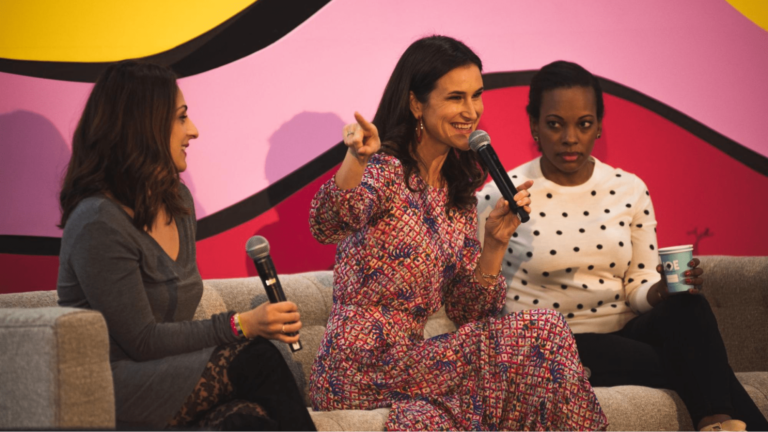Have you ever got up to speak in front of a large group of people and totally blanked as soon as you’re handed the microphone?
Panel events are a brilliant way to share knowledge, engage your audience, and stimulate networking experiences. But as the panel organizer, it’s your responsibility to ensure your panel is set up to create the best possible experience for your guests.
That’s why we’ve created this guide about how to moderate a panel discussion. Read on to get a step-by-step guide on how to moderate a panel and pro tips on how to take your panel to the next level.
Here at Eventbrite, organizers use our all-in-one platform to set up and execute a wide range of panel-style events — and we want to share some top tips we’ve uncovered along the way.
Table of contents
How to prepare for a panel discussion
How to moderate a panel discussion: A step-by-step guide
Five pro tips for how to moderate a panel discussion

How to prepare for a panel discussion
The key to successfully moderating a panel event is preparation. That means learning about your panelists, creating a list of questions in advance, and providing question cards and potential follow-up questions to avoid awkward silences.
To help you get started, we’ll break down the preparation process into three key steps.
1. Learn about your event panelists
Each panelist will have their own reasons for participating. Take the time to understand your panelists, why they’re on the panel, what they want to get out of it, any key messages they want to get across, and any questions they’d like to ask.
Research your panelists on LinkedIn, Twitter, or their company or personal website, and set up a video call with each panelist beforehand or connect with them through email.
Check that you know how to correctly pronounce their name and their company name and know how they want to introduce themselves. Inform all panelists about the event’s background, the audience, the panel topic, and who you and their fellow panelists are.
💡Pro tip: If you want to film the panel and/or use the content in any way after the event, verify that each panelist is comfortable with this, and ideally, ask them to sign a model release waiver.
Start planning your panel event now

2. Prepare a panel outline
Panel discussions often seem totally spontaneous, but good ones rarely are. If you’re a conference organizer, creator, or corporate event planning professional putting together a panel for your next event, create an event outline so everyone knows the score and how to prepare.
According to the experts at TED, most expert talks or panels should last for around 90 minutes. If you’re in search of a panel discussion moderator script, here’s an outline example:
- Introduce yourself.
- Introduce the discussion topic (and why it’s important).
- Introduce the panel format: Review any housekeeping items and technology you’ll use that the audience should know about.
- Introduce the panelists, but keep it brief: This one’s important enough to mention twice: Be 100% sure you have each panelist’s name and company name correct.
- Start with prepared questions: Stick to the key areas you want to discuss, and cover the areas each panelist wants you to ask, plus any other key topics. The extent to which you map out all the questions will depend on your comfort with the topic and how structured you like to be. But you should have an overall flow and narrative in mind. Have more questions than you think you’ll need.
- Leave time for the Q&A: If you leave too much time, there’s a risk the questions will dry up, and if you leave too little time, your audience could be frustrated that the ‘interactive discussion’ isn’t very interactive. For a 45-minute panel, we recommend around 15 minutes for audience questions.
💡Pro tip: Share your panel outline with guest speakers and your event team. This will give your panelists the chance to suggest revisions. For example, they may not feel qualified enough to offer a piece of advice on certain discussion topics, so they might ask you to replace it with another question.

3. Conduct your day-of preparations
Check the setup so you can rest easy knowing everything you’re using works properly. If your event takes place in person, check the panelists all have chairs, water, and functioning microphones. If you have extra microphones for the audience questions, determine who will manage them.
For virtual conference platforms, conduct a walk-through of the panel without an audience before the day of the event.
💡Pro tip: Not sure how to arrange your event space? The ideal in-person setup uses sofas or comfortable chairs arranged in a line or shallow curve, with the panel moderator sitting at one end at the same height as the panelists. This makes it easier for the panelists to interact with each other. To avoid confusion, seat the panelists in the same order they’re listed on your background slide.

How to moderate a panel discussion: A step-by-step guide
Now that you’ve laid down all the groundwork, it’s time to start welcoming guests and warming up the stage lights. But if you’re unsure how to moderate a panel discussion, don’t stress!
Take some deep breaths, relax, and we’ll walk you through the panel discussion process.
1. Welcome your attendees
Your first step toward creating a lively discussion event is to give your guests a warm welcome. Here’s how to do it:
- Check in your attendees with ease: Use a tool like the Eventbrite Organizer App. It enables event staff to scan guests in quickly — meaning you won’t get bottlenecks at the door, and you’ll have real-time updates on attendance figures to know when to start.
- Give your audience a five-minute warning: When your panelists are ready, warn the audience that this is their last chance to use the bathroom, get refreshments, and find their seats before the event starts.
- Encourage your audience to turn off their phones: Nothing kills the vibe of an informative panel discussion more than constant phone notifications from the audience. Before you start the event, politely remind your audience to switch their phones to silent mode.
Want to see the right way to welcome guests to a virtual panel discussion? Take a look at how Eventbrite welcomed guests to this online session of our annual RECONVENE event.
With the help of the one-of-a-kind DJ Prashant, guests tuned in to a cool and upbeat DJ set to get them hyped and ready for the event:
2. Introduce the topic and discussion goals
Set the stage for your audience and remind them why they’re attending and what they can expect from the panel discussion.
Here are some great ways to introduce your topic:
- Start with a video: Play a short but engaging video that visually introduces the scale of the problem you discuss and why it matters.
- Provide hard numbers: Use reputable facts and statistics to demonstrate the scope of the topic at hand.
- Explain the goal of your event: Tell your audience what your panel discussion will achieve. For example, maybe your audience will leave your event with more knowledge on how to untangle common workplace disagreements.
Just make sure to keep it short and sweet. A great introduction is essential, but your audience members aren’t there to hear you talk. They want to hear from the experts.
3. Introduce your panel
Next, tell your audience who’s on your panel and why they’ve been invited to speak. If you’re not used to providing intros, here are a few pro tips:
- Introduce your panelists in the order they’re sitting: This should help your audience remember which expert is which to avoid confusion — but it’s also worth including a slide on-screen that shows everyone’s picture above their name.
- Start with their title and name: Professional qualifications are relevant, so don’t forget them, either.
- Provide a brief description of their experience: In a few sentences, quickly break down each panelist’s career or interests to demonstrate their authority in this area.
For an informal discussion, let each panelist introduce themselves. Just cap each introduction and try to keep them roughly even by allocating them the same amount of time.
4. Share ground rules for the discussion
Informative discussions need ground rules. This ensures everyone has the chance to speak their views and challenge points they disagree with and provides time for the audience to have some input.
Here are the basics you should cover:
- Give your audience the event schedule: This manages expectations around how long guests will speak and how the format will look.
- Provide each panelist a set amount of time: To make sure you don’t run over or give one panelist more airtime than others, set time limits for each answer and let everyone know this time limit.
- Allow time for responses: If your panel includes people with opposing views, provide time after each question for other panelists to chime in or offer a rebuttal.
- Let your audience know there will be time for questions at the end: This will minimize interruptions from the crowd, so panelists get to share their views during the discussion.

5. Ask your questions
Now, it’s time to give the audience what they came for. Kickstart your emcee duties by asking your panelists questions.
Just remember these tips:
- Speak slowly and clearly: If your audience doesn’t understand your question, the answer won’t make sense, either!
- Build in silences: Ensure there’s a short pause before and after each response so that nobody’s interrupting one another. Taking a sip of water is a great way to naturally introduce a pause (and stay hydrated).
- Stick to the rules: As you work your way through your list of questions, make sure you and your panelists are observing the ground rules that you laid out for your panelists.
6. Open up the discussion to your audience
This is the part of the panel discussion where your audience gets to chime in with their thoughts or questions.
Here’s what to do:
- Introduce the Q&A portion: Explain that it’s time for the audience to ask their own questions, and suggest potential areas from the discussion that they may want to revisit.
- Give the audience ground rules: Before you start taking questions, let your audience know how much time you’ve got for questions or any topic areas that are potentially off-limits.
- Have event staff ready: There should be a member of staff ready with a mic to work through the crowd. This keeps things moving and avoids awkward silences.
- Prompt your panelists: After an audience member asks a question, match each question with the most applicable panel member. This will keep things moving quickly!
7. Summarize and wrap up your discussion
After your audience Q&A, it’s time to conclude your panel discussion event. Here’s how to do it:
- Explain that your time is up: This is important so the event doesn’t end abruptly without any warning.
- Remind everyone what they’ve learned: Summarize the key points your panel touched upon.
- Turn those key points into action items: Give your event impact by suggesting the next steps your audience can take after listening to your panelists. For example, after listening to your panelists talk about tips for planting fruit trees, you can encourage your audience to get home and start planting seeds in their own gardens.
- Thank everyone involved: Thank your panelists for their time and experience, but don’t forget to thank the audience for showing up and asking insightful questions, too.

Five pro tips for how to moderate a panel discussion
We’ve covered the process of how to moderate a panel discussion. But if you’re ready to kick it up a notch, try out these pro tips. They’ll keep the conversation flowing, engage your audience, and maximize your event’s impact.
1. Start with simple questions
After introductions, give your guests a broad or easy question to break the ice and get things warmed up. This will give them a chance to find a groove so you can showcase their expertise.
Want to see how this works in practice? Check out the soft start to this Eventbrite RECONVENE session in which we ask our guests a few informal and conversational questions to get them warmed up before diving headfirst into each topic:
2. Let panelists open up and disagree
Don’t feel the need to have every panelist answer every question, as this takes too long and can seem forced.
You can also encourage the panelists to react to and build on each other’s answers. For example, after one of your panelists answers a question, ask your next panelist what they think of that answer. Not only will this move the conversation along organically, but it could also help panelists and guests challenge their own views.
According to researchers at the University of Kansas, people are more likely to consider opposing viewpoints when they get the opportunity to listen to the lived experiences of others. A panel discussion is the perfect place to open up about those experiences.
3. Engage your audience with polls
It’s nice to involve the audience early on, as it encourages participation and engagement.
Poll the audience and ask for a show of hands around what industries they work in, what type of jobs they have, or something else relevant to the panel topic. Many live streaming tools like Zoom and Facebook Live have polling tools that you can use to engage with your audience.
Use audience polls before your event to help create the discussion agenda.
For example, Rockledge Gardens will set up a social media poll a few days before their Love in the Gardens event so guests get to decide the movie at its outdoor cinema.
4. Add breakout sessions during your panel event
Breakout sessions are another great way to boost audience engagement, and they’re possible both in-person and online.
For inspiration, check out the Cobb School Counselor Association and their recent Mini Conference event.
The event included multiple live breakout sessions to allow guests the chance to add more knowledge to their counseling toolbox.
5. Choose the right event technology
When hosting a virtual panel, decide if you want to allow audience members to unmute their devices and ask questions or if you plan to use Q&A tools to take written questions.
Simplify your panel discussion by partnering with an all-in-one platform like Eventbrite to:
- Create an event page and sell tickets
- Create custom seating arrangements
- Utilize integrations with Zoom and Vimeo for live streaming
- Easily check your guests in using the Eventbrite Organizer App
- Market your event using advanced, built-in digital marketing tools
- Engage your audience using a range of app integrations
Clear on how to moderate a panel discussion?
When it comes to how to moderate a panel, there’s no right or wrong way to steer your own event conversations. You’ve just got to plan carefully, get to know your panelists, and go into the panel discussion with clear goals.
Just remember to engage with your audience and do your best to showcase the knowledge your panelists are bringing to the table. And don’t forget to partner with an events management platform like Eventbrite that’ll make managing your event simple and stress-free.






